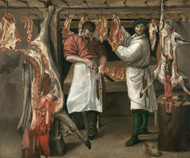Annibale Carracci (November 3, 1560 – July 15, 1609)
Published by Therese Myles on 18th Feb 2020
Annibale Carracci helped develop the Baroque style of painting, which is one of the most important and influential styles of painting in all of art history. He was born in the year 1560 and died in 1609 at the age of forty-nine. Annibale Carracci managed to contribute a great deal to European art during his relatively brief life.
Unlike artists in the Middle Ages, during the Renaissance, more and more artists were taking their inspiration from the natural world. A great deal of Renaissance artwork looks more realistic than Middle Ages artwork, which is partly because Renaissance artists were interested in celebrating humanity and nature in general. Annibale Carracci was very much inspired by this tradition, and was unimpressed by the Mannerism movement that dominated Bolognese art at the time. He was particularly fascinated by the play of light and shadow on various forms. He also tried to depict movement through distinctive new brush techniques.
He is not as famous today as some artists from this time period, which is primarily a function of the fact that Annibale Carracci's life story is somewhat tame compared to that of some of the more well known historical artists. In terms of personality, Annibale Carracci seems to have been a somewhat withdrawn, quiet man. He grew up in dramatic and uncertain times, so the fact that Annibale Carracci has able to triumph as an artist and maintain an apparently stable life is a testament to his character and his dedication to his art.
Annibale Carracci lived in Bologna, which was in a transitional state during his lifetime. The area was full of starving peasants and people suffering from the effects of the plague. While Annibale Carracci was born into the artisan class, artisans didn't have it much better than the peasants in Bologna during his lifetime. While in some societies, artisans formed something resembling the middle class of today, in Bologna at this point in time, many artisans were unemployed in a society that offered little to no support for people without jobs or the right familial connections. Annibale Carracci's father was employed as a tailor. Money was always tight at home, and Annibale Carracci left school when he was eleven. From there, Annibale Carracci worked as an apprentice to a goldsmith.
Annibale Carracci did have some advantages in life, and one of his main advantages was the simple fact that some of his family members were artists themselves. His unique gift with art was first identified by his cousin Ludovico Carracci, who was already a reasonably successful painter. In societies like his, a person's family connections were often everything, and it's possible that Annibale Carracci would have gone on to become a goldsmith if it weren't for Ludovico. From there, Annibale Carracci went on to become an art student, working under Bartolomeo Passerotti, an established and distinguished artist. In 1589, along with his cousin Ludovico Carracci and his brother Agostino, Annibale Carracci started the Academy of the Desirous.
Many of the older, more established artists in Bologna were intimidated by the fairly radical new Academy of the Desirous, even though young artists were largely very enthusiastic about it. Later in life, Annibale Carracci become well known enough to attract the attention of patron Cardinal Farnese, which was very much a mixed blessing for Annibale Carracci in the long run. On the one hand, while working with Cardinal Farnese, Annibale Carracci produced the greatest paintings of his life, which are still on display in museums today. On the other hand, Cardinal Farnese more or less cheated him out of most of his earnings, which proved to be demoralizing for Annibale Carracci. However, his paintings have certainly lived on, while Cardinal Farnese is largely forgotten today.

